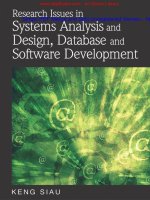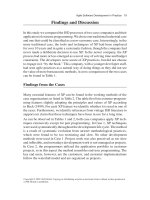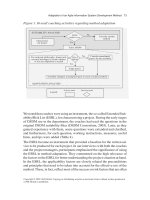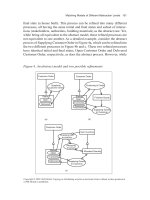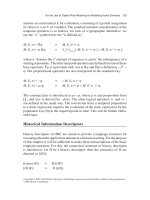Ountline of subject infomation systems analysis and design
Bạn đang xem bản rút gọn của tài liệu. Xem và tải ngay bản đầy đủ của tài liệu tại đây (83.28 KB, 9 trang )
ACADEMY OF FINANCE
UNIT OF IT IN ACCOUNTING AND FINANCE
OUTLINE OF SUBJECT:
INFORMATION SYSTEMS ANALYSIS AND DESIGN
1. List of lecturer
No
Name
1 Vũ Bá Anh
Phan
2 Phước
Long
3
Hoàng Hải
Xanh
Date of
Degree
Birth
1960
1973
1978
Graduated
University
Speciality
PhD
National
Economics
University
Informatics Lecture
Economics
r
MSc
Hanoi
National
University of
Education
Informatics
MSc
Technology
College,
Vietnam
National
University
Information Lecture
Technology
r
Job
Lecture
r
Phone;
4
Đồng Thị
Ngọc Lan
1982
MSc
Hanoi
National
University of
Education
Informatics
Lecture
r
2. General Information of subject
- Name of subject: Information Systems Analysis and Design
- Code of subject: ISD0136
- Number of credits: 4
- Prerequisite: Student have finished subjects: Basic program 2, Database 1
- Time total: 176 (hours)
Theory: 42 (hours)
Exercise: 12 (hours)
Discussion: 6 (hours)
Practice:0 (hours)
Group work: 10 (hours)
Self – Study: 116 (hours)
- Address: Unit of IT in Accounting and Finance, room 204, Library Building
3. Objective of Subject
- Knowledge: Providing knowledge, methods, models and tools to carry out the
analysis, design an information system.
- Skills: Have skills to analysis and design an information
- Require: Full - time
4. Description of Subject
The subject provides knowledge, methods and models for analysis and design
of information systems, especially in management information systems. The main
stages in the development of an information system are: Survey and assess the
status of the system; Determine the objectives; Determine the Systems Scope; The
ability of the project; Systems analysis; System design; installation, exploitation and
maintenance of the system.
5. Content of subject
Chapter 1: Overview of Information System
1.1
1.1.1
1.1.2
1.2
1.2.1
1.2.2
1.2.3
1.2.4
1.3
1.3.1
1.3.2
1.3.3
1.4
1.4.1
1.4.2
1.4.3
1.4.4
Information System
Concept
Type of Information System
The information processing methods of the computer
Interactive process
Batch process
Realtime process
Distribution process
The approach in the development of information system
Modeling system
The method of system modeling
The approach in the development of information system
Project Management Information System Development
Project Conception and Initialization
Project Definition and Planning
Project Execution
Project Close
Chapter 2: Research
System
status
requirements
2.1 Survey
2.1.1 Introduction
2.1.2 Investigation sources
2.1.3 Investigation methods
2.1.4 Investigation process
2.1.5 Handling the investigation results
2.1.6 Investigation assess
and
determination
of
system
2.2 Project Initialization and Planning
2.2.1 Determination scope
2.2.2 Determination Objective
2.2.3 Possible research
2.2.4 Project Planning
Chapter 3: Analysis of Business Funtional System
3.1 The level of business function description
3.1.1 The physical and logical level descriptions
3.1.2 Overview and detailed descriptions
3.2 Models and tools describe business function
3.2.1 Business function models
3.2.2 Performing business function
3.2.3 The functional specification tool
3.3 Method of determining the business function model
Chapter 4: System Analysis of Business Data
4.1 The process of data modeling
4.2 Some means of describing data
4.2.1 Encoding Name
4.2.2 Data Dictionary
4.3 Entity Relationship Model (ER)
4.3.1 Concepts of ER
4.3.2 The graphical notation to represent the concept of model ER
4.4 Enhanced Entity Relationship Model (EER)
4.4.1 Superclass, subclass and inheritance
4.4.2 Chart EER
4.4.3 How to convert the EER model to ER model
4.5 Methods of data analysis in the model of ER
4.6 Relationship Model
4.6.1 Basic concepts of Relationship Model
4.6.2 Relational DataBase, Relationship constraints
4.6.3 Operations on the relationship model
4.6.4 Funtional dependence and Key of Relationship
4.6.5 Standard types of relationship
4.7 Transfer methods ER model into a relationship model
Chapter 5: System Design
5.1 The Overall Design
5.1.1 Introduction
5.1.2 Dividing the system into subsystems
5.1.3 Identify the subsystems implemented by machine
5.2 Database Design
5.2.1 Introduction
5.2.2 Construction logical diagram
5.2.3 Construction physical diagram
5.3 Program Design
5.3.1 Introduction
5.3.2 Construction module diagram
5.3.3 How to convert from the data flow graph to chart module
5.3.4 Specification of modules of the program
5.4 Interface Design
5.4.1 Form Design and Report Design
5.4.2 Interaction Design
5.4.3 Dialogue Design
5.5 Selection of installation models
Chapter 6: System Installation
6.1 Installation strategy
6.2 Selection of installation models
6.3 Selection of installation Environment
6.4 Selection of installation tools
Chapter 7: Overview of Object - Oriented Analysis and Design
7.1 Object-oriented approach in the analysis and Design
7.2 Overview of Object - Oriented Program
7.3 Process of implementation of object-oriented analysis
7.4 Process of implementation of object-oriented Design
6. References
[1]Anh, Vu Ba, Information Systems Analysis and Design, Academy of Finance
[2] Ba, Nguyen Van, Information Systems Analysis and Design, Ha Noi National
University, 2006.
[3] Nguyễn Văn Vỵ, Modern Information Systems Analysis and Design, Thong Ke
Publisher, 2002.
[4] Merle P.Martin, Analysis and Design of Business Information Systems, Second
Edition, Prentince Hall, 1995.
7. Organizational forms of teaching and allocation of study time
Organ
Content
Chapter 1
Chapter 2
Chapter 3
Chapter 4
Chapter 5
Chapter 6
Chapter 7
Total
8. Requirements for students
- Time that work at classroom over 80%
- Cctively participate in classroom activities
- Doing assignment exercises sucessful
- Have to pass two test
9. Method, test forms - learning outcomes assessment
9.1 Regular check and regular assessment: through preparing homework,
preparing discussion theory questions & evaluation self - study section
9.2 Periodic checks and evaluations
- Participation in class learning: attendance, punctuality. Prepare all good &
positive discussion. Weighting of 5%
- The self-study: to complete fulfill content and tasks assigned by teachers in the
period: 5%
- Positive group activities: 5%
- The mid - term test :15%.
- The last – term test: 70%
9.3 Evaluation Criteria of the types of exercises
- Personal exercises
- Group exercises
9.4 Exam schedule, test, retest
- Number of tests: 2 post. 1st test at the end of chapter exercises 3, 2nd test after
finishing the whole program.
- Exam schedule : Under the provisions of the Academy of Finance
Leader of Academy of Finance
Header of Units


